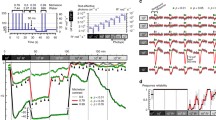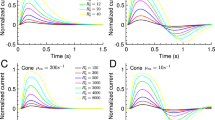Abstract
Rod dark adaptation in the amphibian retina appears to be due to three processes: 1. background adaptation, occurring immediately after the extinction of an adapting or bleaching light, 2. intermediate adaptation, that frequently lasts 30 min or more and 3. opsin adaptation, which in the isolated retina where regeneration of rhodopsin is insignificant, is observed as a permanent loss of sensitivity after the completion of intermediate adaptation. Intermediate adaptation is characterized by a linear relation between log threshold and the amount of “retinal” present, a similar relation is obtained between log threshold and the amount of rhodopsin bleached in opsin adaptation.
These adaptation processes are discussed in terms of a model of the rod outer segment.
Similar content being viewed by others
References
Baylor, D. A., Hodgkin, A. L., Lamb, T. D.: The electrical responses of turtle cones to flashes and steps of light. J. Physiol. (Lond.) 242, 685–727 (1974)
Bownds, D., Dawes, J., Miller, J., Stahlmann, M.: Phosphorylation of frog photoreceptor membranes induced by light. Nature (Lond.) New Biol. 237, 125–127 (1972)
Donner, K. O.: Rod dark-adaptation and visual pigment photoproducts. In: Biochemistry and physiology of visual pigments (ed. H. Langer), pp. 205–209. Berlin-Heidelberg-New York: Springer 1973
Donner, K. O., HemilÄ, S.: Kinetics of long-lived photoproducts in the frog retina as a function of the amount bleached. Vision Res. 15, 985–995 (1975)
Donner, K. O., Reuter, T.: Dark-adaptation processes in the rhodopsin rods in the frog's retina. Vision Res. 7, 17–41 (1967)
Grabowski, S. R., Pak, W. L.: Intracellular recordings of rod responses during dark-adaptation. J. Physiol. (Lond.) 247, 363–391 (1975)
HemilÄ, S.: Background adaptation in the rods of the frog's retina. J. Physiol. (Lond.) (in press) (1976)
HemilÄ, S. O., Donner, K. O.: The dark adaptation of isolated frog retina after varying bleaching periods. Exp. Brain Res. 23 (Suppl.), 86 (1975)
Kleinschmidt, J., Dowling, J. E.: Intracellular recordings from Gecko photoreceptors during light and dark adaptation. J. gen. Physiol. 66, 617–648 (1975)
Kühn, H., Cook, J. H., Dreyer, W. J.: Phosphorylation of rhodopsin in bovine photoreceptor membranes — a dark reaction after illumination. Biochemistry 12 (13), 2495–2501 (1973)
Miller, J. A., Paulsen, R.: Phosphorylation and dephosphorylation of frog rod outer segment membranes as part of the visual process. J. biol. Chem. 250, 4427–4432 (1975)
Naka, K. I., Rushton, W. A. H.: S-potentials from luminosity units in the retina of the fish (Cyprinidae). J. Physiol. (Lond.) 185, 587–599 (1966)
Rushton, W. A. H.: Visual adaptation. The Ferrier Lecture 1962. Proc. roy. Soc. B 162, 20–46 (1965)
Rushton, W. A. H., Powell, D. S.: The early phase of dark adaptation. Vision Res. 12, 1083–1093 (1972)
Author information
Authors and Affiliations
Rights and permissions
About this article
Cite this article
Donner, K.O. Dark adaptation processes in the amphibian rod. Biophys. Struct. Mechanism 3, 171–173 (1977). https://doi.org/10.1007/BF00535814
Received:
Issue Date:
DOI: https://doi.org/10.1007/BF00535814




